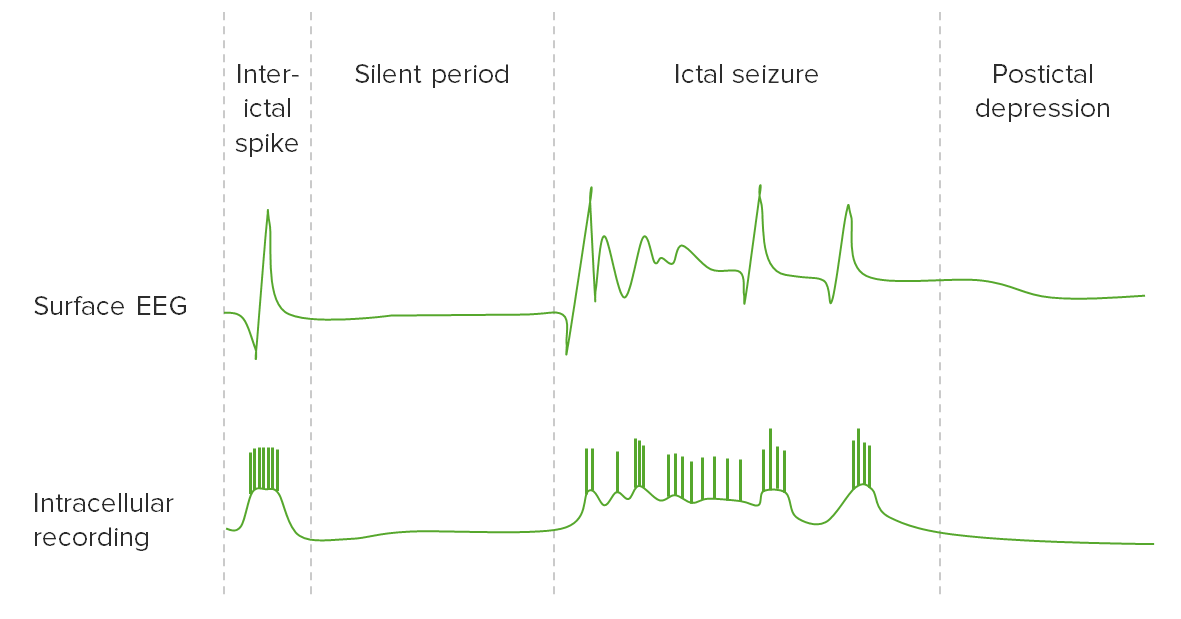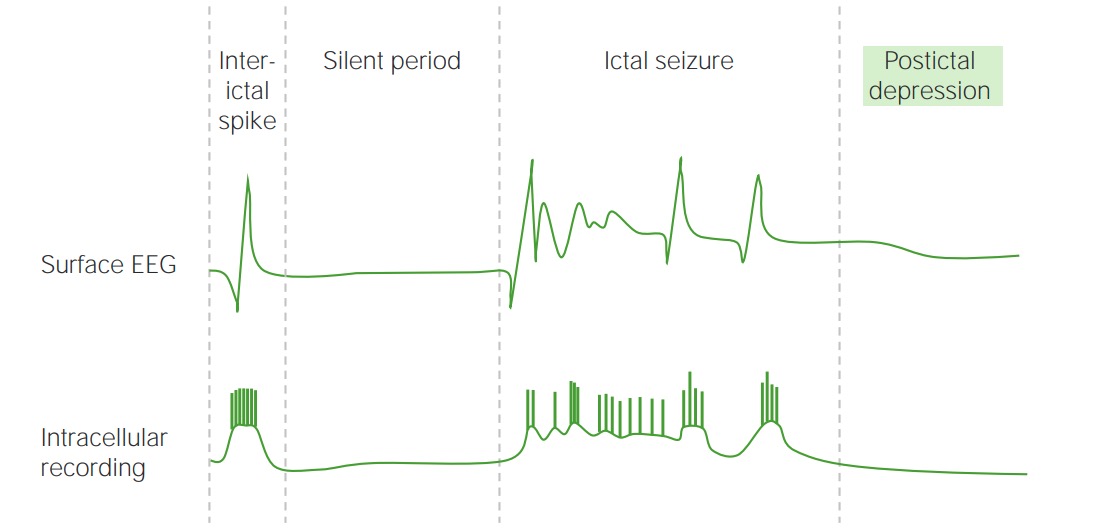Playlist
Show Playlist
Hide Playlist
Diagnosis and Evaluation of a Spell with Case
-
Slides Seizures Epilepsy Approach to a New Spell.pdf
-
Download Lecture Overview
00:01 In this lecture, we'll talk about the approach to a New Spell. 00:05 How do we evaluate patients presenting with a spell, and determine whether it is or is not a seizure? Let's start with a case. 00:13 There's a 45-year-old man who's brought to the emergency department for evaluation of a new spell. 00:19 The man's family reports that he's been ill for about two weeks with a viral gastroenteritis. 00:24 He describes nausea and vomiting for which he was treated symptomatically with ondansetron or Zofran. 00:31 On the day of admission, the patient has been sitting at the kitchen table when he got up to walk into another room. 00:37 His wife reports that about halfway into the room, the man fell to the ground, and then began convulsing when he was on the ground. 00:46 Both arms and legs jerked for about 15 to 30 seconds. 00:50 After about a minute, the patient "came to" and immediately was aware. 00:54 He looked around, he was able to speak, describes who he was in the room. 00:59 His family called 911, and he was taken to the emergency department. 01:02 The patient says that he remembers walking into the room feeling lightheaded. 01:07 Examination in the Emergency Department shows a normal neurologic examination. 01:12 So what's the diagnosis? Well, there are a number of key features in this case that we evaluate in all patients who are presenting with a new onset spell or seizure. 01:23 The first thing we look at is what happened before the episode, what was going on for it with a patient and what is the patient described. 01:31 Here, the patient describes, walking into a room feeling lightheaded, dizzy, maybe even faint if we investigated further. 01:38 And that's critical information to differentiate between a seizure and something else. 01:44 The second thing we evaluate is what happened in the episode itself. 01:48 And here we see two things. 01:50 We see that first, the man went to the ground, fell to the ground. 01:54 And then after that, convulsive activity, jerking of the arms and legs on both sides, was present for about 15 to 30 seconds. 02:03 And then the third thing we look at is what happened after the event. 02:07 And here the patient was immediately aware, there was not a post event or postictal confusion episode or phase or period of time. 02:16 The man was immediately aware and that's important again, in differentiating seizures from other causes, like syncope. 02:26 So what's the diagnosis? Focal-onset convulsive seizure? Narcolepsy with cataplexy, generalized-onset convulsive seizure or convulsive syncope? Well, this doesn't sound like focal-onset convulsive seizure. 02:42 The patient didn't describe focal-onset of symptoms, there is not postictal confusion, and the symptom description really fits more convulsive syncope than something else. 02:54 How about generalized-onset convulsive seizure? Again, the patient doesn't have postictal confusion or symptoms that would indicate seizure and the description is really more consistent with syncope and convulsions secondary to the syncope. 03:09 How about narcolepsy with cataplexy? Narcolepsy, and specifically, cataplexy can look a lot like a seizure. 03:16 But this description lacks those typical symptoms of narcolepsy including excessive daytime sleepiness. 03:22 And importantly, cataplexy involves transient episodes of muscle weakness with retained awareness and this patient was not aware during this episode. 03:32 So the right answer here is convulsive syncope. 03:34 This is the typical presentation of convulsive syncope. 03:37 There's no aura, the patient initially had an episode of fainting syncope, followed by convulsions, and this event lacked postictal confusion, all of the features that we see with convulsive syncope. 03:52 So let's start with a differential diagnosis for spells and seizure mimics. 03:57 So a patient presenting with spell could have a seizure, but we can also see psychogenic non epileptic spells. 04:04 Syncope or convulsive syncope, as in this case, which may be orthostatically, induced from changes in position or from a cardiac arrhythmia. 04:13 Anxiety attacks can cause a very similar presentation, metabolic derangements, hypoglycemia, hypoxia, or medication side effects. 04:23 Migraines, transient ischemic attacks can also present with paroxysmal episodes of neurologic dysfunction, movement disorders, paroxysmal dyskinesia, tic disorders, or hemifacial spasm can present with repetitive motor activity, breath holding spells in kids, as well as nocturnal disorders. 04:41 Paroxysmal sleep disorders like narcolepsy, REM behavior disorder, and parasomnia. 04:46 So there's a number of things that can present with a spell. 04:51 When we're evaluating the spell and determining whether this is a sheet seizure, or one of those seizure mimics, there are a few considerations to think about. 04:59 You usually don't get to see the spell. 05:01 And so the history is critically important for evaluating these patients. 05:05 In fact, one of the famous neurologists epileptologist, once said, the aim of evaluating patients is to determine precisely and reliably as possible, the objective characteristics and course of a sudden, brief, unexpected event that has occurred in a highly emotional context, and is only partially recalled, often in a biased manner, by both the patient and witnesses. 05:28 So clearly, our job is a tough one, we've got to peer into what happened in this emotionally charged poorly recollected in some cases event and understand what it is. 05:38 And so a systematic and comprehensive history is really important when evaluating these patients. 05:44 Typically, when we approach the history, we divide each of the episodes up, and we first asked about the first stereotypic event, how did it begin, what happened during the event, and what happened after the event in that post event or postictal phase? Then we move to the second stereotypic event, what happens at the beginning during the event and after the event? And these features help us to hone in on whether it is a seizure or not a seizure and what the precise diagnosis may be. 06:13 So what are the some of the other things that we ask about on history and physical? We do a comprehensive past medical history, look at medications and allergies. 06:20 There are a number of medications that can lower the seizure threshold. 06:24 Tramadol or Ultram, Wellbutrin or bupropion are some of the medications that can lower the seizure threshold, as well as some antibiotics like ciprofloxacin or the fluoroquinolones. 06:34 So we asked about those and look for a medication that may have incited this event. 06:39 We look at family history and ask about a family history of seizure which can tip us off to an inherited cause or heritable epilepsy. 06:48 We look at a social history, asking about drugs of abuse or withdrawal of medication, specifically benzodiazepines which can precipitate a seizure. 06:56 Talk about psychosocial stressors and look for a history of sexual emotional or physical abuse.
About the Lecture
The lecture Diagnosis and Evaluation of a Spell with Case by Roy Strowd, MD is from the course Seizures and Epilepsy.
Included Quiz Questions
Which statement is true when evaluating a patient for an epileptic spell?
- Questions should be asked in a systematic manner.
- Events immediately after the spell are of little diagnostic value.
- Because of bias, witness testimony should not be considered during the diagnosis.
- Patients will likely have a good recall of events during the spell.
- Events before the spell are of little importance.
Which statement regarding the differential diagnosis of a spell is the most accurate?
- Convulsive syncope usually has a period of unconsciousness prior to convulsions.
- Narcolepsy with cataplexy is a condition that only impacts patients while sleeping.
- Migraines usually cause convulsions.
- A transient ischemic attack will not mimic a seizure.
- Substance abuse history is not required to make a diagnosis
Customer reviews
5,0 of 5 stars
| 5 Stars |
|
5 |
| 4 Stars |
|
0 |
| 3 Stars |
|
0 |
| 2 Stars |
|
0 |
| 1 Star |
|
0 |





